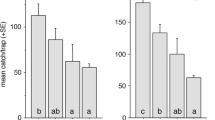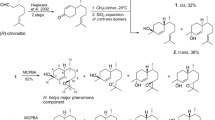Summary
The attractive power of disparlure—the sex attractant of the gypsy moth (Lymantria/Porthetria dispar)—vs. four synthetic analogous epoxides was tested in 1972 in a pine forest near Heidelberg. With two levels of concentration in the traps (2 and 20 μg), a total of 1112 nun moths (Lymantria/Porthetria monacha) and 257 gypsy moths were caught in 9 experiments. Approximately equal percentages of the two species were caught with a given compound. Disparlure was by far the most effective attractant. The other substances were between three and twenty times less effective. These experiments support the assumption that disparlure is also at least part of the sexual attractant of the nun moth. In two additional experiments, moth captures by a series of increasing disparlure concentrations (2–100 μg/trap) were determined. The catches of both species increased nonlinearly with the bait concentration. The experiments are discussed with respect to new (unpublished) electrophysiological recordings from disparlure receptor cells in both species. Special attention is given to the supposed masking effect of the disparlure precursor (an olefin). This substance is ineffective as an attractant, but has been reported to reduce the attraction of gypsy moth males to disparlure or to live females. However, the olefin elicits excitatory reactions in the same type of receptor cell that responds to disparlure and the related epoxides. Furthermore, no masking of the electrophysiological response was observed with the receptor cells when the olefin was added to disparlure.
Similar content being viewed by others
References
Adler, V. E., Beroza, M., Bierl, B. A., Sarmiento, R.: Electroantennograms and field attraction of the gypsy moth sex attractant disparlure and related compounds. J. Econom. Entomol.65, 679–681 (1972)
Beroza, M.: Nonpersistent inhibitor of the gypsy moth sex attractant in extracts of the insect. J. Econom. Entomol.60, 875/876 (1967)
Beroza, M., Bierl, B. A., Knipling, E. F., Tardif, J. G. R.: The acticity of the gypsy moth sex attractant dispalure vs. that of the live female moth. J. Econom. Entomol.64, 1527–1529 (1971a)
Beroza, M., Bierl, B. A., Tardif, J. G. R., Cook, D. A., Paszek, E. C.: Activity and persistence of synthetic and natural sex attractants of the gypsy moth in laboratory and field trails. J. Econom. Entomol.64, 1499–1508 (1971b)
Beroza, M., Knipling, E.F.: Gypsy moth control with the sex attractant pheromone. Science177, 19–27 (1972)
Bierl, B. A., Beroza, M., Collier, C. W.: Potent sex attractant of the gypsy moth: its isolation, identification and synthesis. Science170, 87–89 (1970)
Bierl, B. A., Beroza, M., Collier, C. W.: Isolation, identification and synthesis of the gypsy moth sex attractant. J. Econom. Entomol.65, 259–264 (1972)
Bierl, B. A., Beroza, M., Cook, D. A., Tardif, J. G. R., Paszek, E. C.: Enhancement of the activity of extracts containing the gypsy moth sex attractant. J. Econom. Entomol.64, 297–300 (1971)
Cardé, R. T., Doane, C. C., Roelofs, W. L.: Diel periodicity of male sex pheromone response and female attractiveness in the gypsy moth and a possible evolutionary change. Canad. Entomologist (in print, 1973a)
Cardé, R. T., Roelofs, W. L., Doane, C. C.: Natural inhibitor of the gypsy moth sex attractant. Nature (Lond.)241, 474–475 (1973b)
Doane, C. C.: Aspects of mating behavior of the gypsy moth. Ann. Entomol. Soc. Amer.61, 768–773 (1968)
Doane, C. C., Cardé, R. T.: Competition of gypsy moth males at a sex pheromone source and a mechanism for terminating searching behavior. Environmental Entomol.2, 603–605 (1973)
Documenta Geigy: Wissenschaftiliche Tabellen, 7. Aufl. Geigy. A. G. Pharma, Basel 1968/69.
Eiter, K.: Neue Totalsynthese des Sexuallockstoffes vonPorthetria dispar (7,8-cis-Epoxy-2-methyloctadecan). Angew. Chemie84, 67/68 (1972)
Görnitz, K.: Anlockversuche mit dem weiblichen Sexualduftstoff des Schwammspinners (Lymantria dispar) und der Nonne (Lymantria monacha). Anz. Schädlingskde.22, 145–149 (1949)
Holbrook, R. F., Beroza, M., Burgess, E. D.: Gypsy moth (Porthetria dispar) detection with the natural female sex lure. J. Econom. Entomol.53, 751–756 (1960)
Jacobson, M.: Insect sex pheromones, New York-London: Academic Press 1972
Kaissling, K.-E.: Insect olfaction, p. 351–451. In: Handb. sensory physiol., Vol. IV, Part 1, L. M. Beidler, Ed. Berlin-Heidelberg-New York: Springer 1971
Kaissling, K.-E., Priesner, E.: Die Riechschwelle des Seidenspinners. Naturwissenschaften57, 23–28 (1970)
Priesner, E.: Die interspezifischen Wirkungen der Sexuallockstoffe der Saturniidae (Lepidoptera). Z. vergl. Physiol.61, 263–297 (1968)
Priesner, E.: Artspezifität und Funktion einiger Insektenpheromone. Fortschr. Zool.22, 49–135 (1973)
Sarmiento, R., Beroza, M., Bierl, B. A., Tardif, J. G. R.: Activity of compounds related to disparlure, the sex attractant of the gypsy moth. J. Econom. Entomol.65, 665–667 (1972)
Schedl, K. E.: Der Schwammspinner (Porthetria dispar L.) in Euroasien, Afrika und Neuengland. Monograph. angew. Entomol., Beihefte zur Z. angew. Entomol., No.12 (1936)
Schneider, D.: Electrophysiological investigation on the olfactory specificity of sexual attracting substances in different species of moths. J. Insect. Physiol.8, 15–30 (1962)
Schneider, D.: Olfactory receptors for the sexual attractant (Bombykol) of the silk moth, p. 511–518. In: The neurosciences: Second study program, F. O. Schmitt, Ed. New York, N. Y.: Rockefeller Univ. Press 1971
Schneider, D., Lacher, V., Kaissling, K.-E.: Die Reaktionsweise und das Reaktionsspektrum von Riechzellen beiAntheraea pernyi (Lepidoptera, Saturniidae). Z. vergl. Physiol.48, 632–662 (1964)
Schneider, D., Steinbrecht, R. A.: Checklist of insect olfactory sensilla. Symp. zool. Soc. (London)23, 279–297 (1965)
Schönherr, J.: Die Wirkung von Disparlure auf die Nonne. Z. angew. Entomol.71, 260–263 (1972)
Schwinck, I.: Freilandversuche zur Artspezifität des weiblichen Sexuallockstoffes der Nonne (Lymantria monacha L.) und des Schwammspinners (Lymantria dispar L.). Z. angew. Entomol.37, 349–357 (1955)
Stevens, L. J., Beroza, M.: Mating-inhibition field tests using disparlure, the synthetic gypsy-moth sex pheromone. J. Econom. Entomol.65, 1090–1095 (1972)
Wilson, E. O., Bossert, W. H.: Chemical communication among animals. Recent Progr. Hormone Res.19, 673–716 (1963)
Author information
Authors and Affiliations
Additional information
Supported by the Deutsche Forschungsgemeinschaft.
Rights and permissions
About this article
Cite this article
Schneider, D., Lange, R., Schwarz, F. et al. Attraction of male gypsy and nun moths to disparlure and some of its chemical analogues. Oecologia 14, 19–36 (1974). https://doi.org/10.1007/BF00344896
Received:
Issue Date:
DOI: https://doi.org/10.1007/BF00344896




